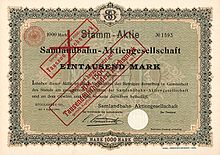Samland Railway
| Samland Railway | |
|---|---|
|
Railways around Königsberg in 1938
| |
| Gauge : | 1435 mm ( standard gauge ) |
The Samland Bahn AG (named after the peninsula Samland ) was on 13 April 1899 by the company Lenz & Co GmbH founded. The Ostdeutsche Eisenbahn-Gesellschaft in Königsberg , which is also part of the AG for Transport Group, took over almost all of the share capital and ran the business.
history
The standard-gauge small railway line started on July 14, 1900 from the Samland station in the north of Königsberg and led in a north-westerly direction through the Samland to Marienhof, where from October 1, 1900 the Fischhausen district railway branched off to Fischhausen . Then from January 21, 1901 , the journey continued northwards to the Baltic coast , which it reached at Neukuhren station . From here a connection of the Königsberg-Cranzer railway company led eastwards to Cranz . In 1928 the Königsberg-Cranzer Eisenbahn and Samlandbahn formed an operating partnership, both of which used the new north station in Königsberg.
The Samland Railway followed the coast in a westerly direction to the Rauschen Ort station , which was located in the south of this popular seaside resort - about 1,600 m as the crow flies from the beach - and reached the terminus in Warnicken after a 45 km journey. On June 2, 1906, a two-kilometer junction and a track triangle to the Rauschen Düne terminus was built between Rauschen Ort and Warnicken to bring visitors to the pool closer to the beach. It is noteworthy that since June 25, 1910, a community-owned cable car with a gauge of 750 mm ran from the high bank down to the beach.
The continuation of the railway from Warnicken had been planned for decades in order to have a continuous railway connection along the entire coast of the Samland from Cranz to Pillau . When the Second World War began, a section of five kilometers between Warnicken and Groß Dirschkeim was still missing . In February 1945, when the Red Army had already conquered large parts of East Prussia , the gap was closed. In order to be able to transport the residents who had fled to the coast to the efficient port of Pillau , the tracks were installed on the route that had been prepared for years and were then transported away from the disused sections. However, only one train with refugees is said to have run before the country was finally occupied.
Since April 1, 1932, the Samland Railway had a bus operation with six lines and a length of 142 kilometers.
Route Königsberg – Warnicken
| kilo meter |
Height m |
bus stop | comment | |
|---|---|---|---|---|
| German | Russian | |||
| 0.0 | Koenigsberg North Station | Kaliningrad Severny | ||
| 4.7 | Kbg.-Charlottenburg | Lermontowo | ||
| 6.9 | Kbg.-Tannenwalde | Chkalovsk | ||
| 8.4 | Goldsmiths | Dimitrowo | ||
| 9.8 | Gallhöfe | |||
| 13.1 | Nod | Druschnoje -Sapadnoje | ||
| 16.3 | Basset germ | Pavlinino | ||
| 17.3 | Willgaiten | Kolossovka- Sapadnaya | ||
| 19.3 | Drug stretch galt sheaves | Op 20 km | ||
| 22.7 | Drugehnen-Marienhof | Pereslavskoye- Sapadnoye | Turn off Fischhausener Kreisbahn | |
| 25.2 | Perteltnod | |||
| 27.6 | Watzum-Pobethen | Gorkovskoye - Romanowo | ||
| 29.6 | Kalthof | |||
| 31.7 | Lixeids | Obuchowo | ||
| 35.2 | Neukuhren (health resort) | Pionerski | Connection towards Cranz | |
| 40.0 | Noise place | Svetlogorsk 1 | ||
| 43.0 | Noise dune | Svetlogorsk 2 | Terminus | |
| 45.2 | Georgenswalde | Otradnoye | Shut down in 2006 | |
| 47.0 | Warning nods | Lesnoye | Shut down in 2006 | |
Current condition of the routes
The Kaliningrad – Svetlogorsk railway line is electrified and is used regularly (around eight pairs of trains a day), as is the Königsberg – Cranz line. There are tracks on the Rauschen - Warnicken - Sorgenau - Fischhausen route , but there is no scheduled traffic. The Fischhausener Kreisbahn (Marienhof– Gaffken ) has disappeared.
literature
- Herbert Meinhard Mühlpfordt : The opening of the Samland Railway on July 14, 1900 . Königsberger Bürgerbrief XVII (1980), p. 8 f.


